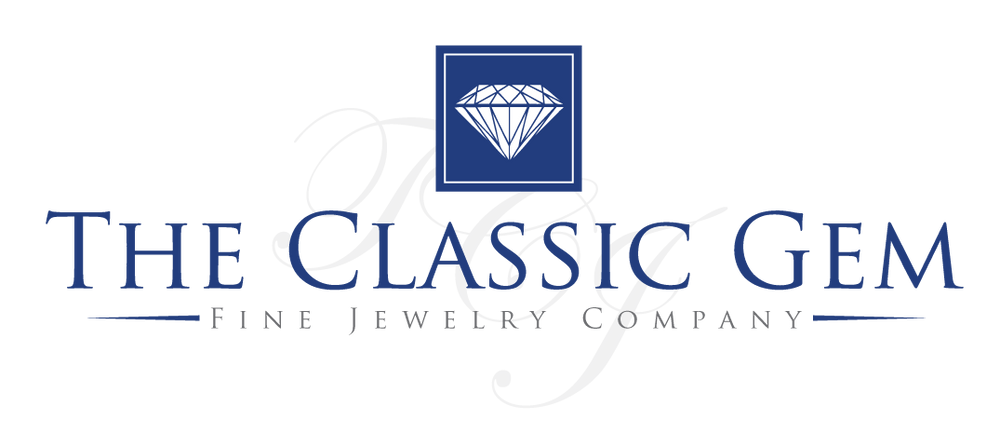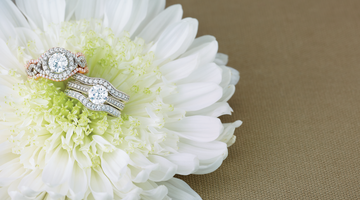The 4Cs stand for Cut (symmetry of facets), Clarity (how clean the diamond looks to the eye or under a loupe), Carat (a diamond's weight or size), and Color (generally how white/colorless or yellow the diamond is), and in no particular order is one more important than the other but rather it is a combination of factors that make-up the overall beauty of diamond. The human eye is most attracted to brilliance and undoubtedly, most people would agree that as long as the diamond has fire and scintillation with no real visible inclusions or flaws to the naked eye, and faces up pretty white (or is not obviously yellow), it will be attractive!
However, there is a lot more to consider beyond the 4Cs when investing in a diamond and there are features to watch out for that impact the beauty and value of a diamond.
Outside the scope of the 4Cs are diamonds that appear to have a milky appearance and/or a brown tint. This is probably one of the most critical factors to consider when buying a diamond as it is least understood, and has a larger impact to the appearance of the diamond regardless of how high the grades for clarity and color are. The diamond could be D-Flawless, and if it has a milky tone, it could appear that the diamond is dull and lifeless and in smaller scales, it takes away from the brilliance of a diamond. The trade refers to these as "BGM", "TLB", "Milky", "Cloudy", just to name a few. BGM stands for "Brown, Green, and/or Milky," and TLB stands for "Top Light Brown." In the trade, these diamonds are sold as a loss, or below market at a deep discount.
For example: Brown Tint, or Top Light Brown (TLB), is a bit easier to identify to those who are more sensitive to color but generally when compared on white paper, and if there is an awareness to look for it, most people can pick it up.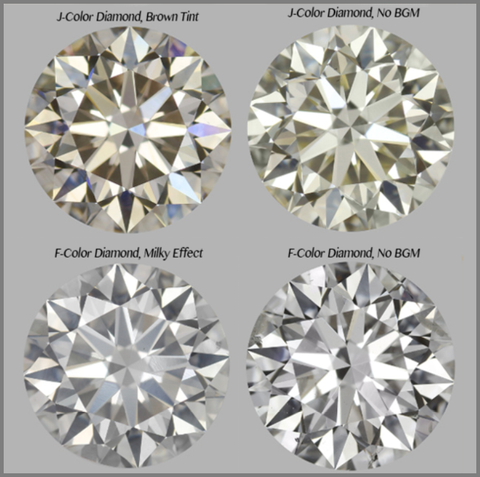
Milkiness, seen in the image below, is a cloudy or opaque look can occur at many levels, some grade them from 0-4, 4 being the most opaque or cloudy and 0 being non-existent, and 1-2 being difficult to identify without a benchmark or trained eyes. This is probably one of the trickiest factors to identify and requires a trained eye, lab environment, lighting and tools, and clear master stones for comparison. The milkiness is caused by microscopic pinpoints that are scattered throughout the entire structure of the rough diamond. The pinpoints are so small that it does not count as a clarity inclusion but a concentrated amount scattered will cause a milky appearance overall. 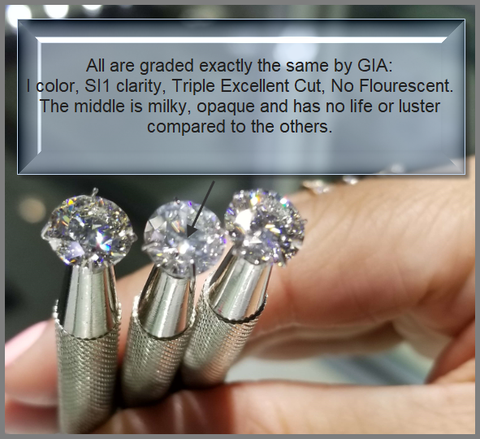
As long as there are NO elements of a brown tinge or an opaque or milky tone, more than likely it will still be beautiful. The key is to make sure that there are no brown tinges and no opaque or milky lusters, and that it is eye clean which on the clarity scale is up to an SI1-2 and in some rare cases even an I1 level can be eye clean, and you will have a dazzling diamond!
Color Scale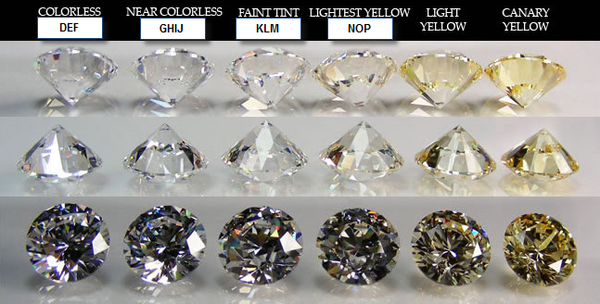
FAQ: Price Range | How do I choose for my budget?
For Quality (Great or Best + Truly Rare)
If budget is not an issue, and you want a diamond that is rare, then D Color, Flawless Clarity, or "D-Flawless" is the best quality available. Can you tell the difference between colorless, and near colorless when mounted, or flawless to slightly included? Not really, but the fact that perhaps less than .01 % of people might have diamonds of that statistics might mean something to you. For instance, all things being equal, a great quality diamond, with no brown tinge or milkiness will range in price as noted below;
- a 1ct D Flawless is roughly 15-20K
- a 1ct G SI1 is roughly 6.5K and up, and;
-
a 1ct J SI2 is roughly 4.5K and up
As long as they are eye clean, with no brown tinge or milkiness, they will sparkle and scintillate and move you equally on its own. Rarity counts, and there's a larger price to pay for it. Diamond prices are also NOT linear, but more exponential so as sizes go up, the price may jump quite a bit.
For Budget and Size (Good to Very Good + a WOW Factor)
Look for a good, white facing K color, or to be on the safer side a I-J color, but be cautious that the diamond does not have a brown tinge! Look for eye clean, meaning if it passes the eye test and you cannot see any inclusions under good lighting. Start from SI2, and if time is on your side, then sometimes an I1 can be eye clean but it takes a lot of patience, perhaps 1 out of 50 I1s can appear to be acceptably eye clean. More likely, SI1-SI2s tend to be eye clean, but also takes a little bit of work to find the best ones. Look for inclusions off to the side or blended in a facet, or inclusions of lighter nature such as pinpoints or twinning wisps. Generally, crystals are black inclusions and can sometimes show but do not always discount them because diamonds with black crystals tend to be the clearest all over. See price ranges below:
- a 2 ct D Flawless is roughly 80-100K and up;
- a 2ct G SI1 is roughly 17-20k and;
-
a 2ct J SI2 is roughly 9-12K.
Prices are definitely not linear! As mentioned before, when mounted as long as they are eye clean, with no brown tinge or milkiness, they will sparkle and scintillate, and move you equally on its own.
For Budget, Size and Quality (Very Good or Better Than Good + Peace of Mind)
This is a tricky one because it can be very subjective, but most people who are unsure of what to choose generally feel better taking the middle road and pick colors that are between G, H, and I, and between a VS2-SI1 clarity. For instance, prices vary, but assuming that it is eye clean, best symmetry and cut proportions and no brown tinge or milkiness;
- a 1.00ct H-I, SI1+ will range approximately 5-8k and;
- a 1.50ct H-I, SI1+ will range approximately 8-12k and;
- a 1.90ct H-I, SI1+ will range approximately 10-15K
***Please note that diamond prices reflected here change on a daily basis and these are estimates from a snapshot from 07/10/2015.
Relevant and Useful Blog Articles
- Beyond the 4Cs of Diamond Buying; Critical Factors That Make a Diamond Stand Out
- All About Cushion Cuts
- Google on BGM
Resources
- Learn more about diamonds and GIA Diamond Grading Reports
- Learn why a GIA Diamond Grading Report is so important
- Learn about diamonds from GIA, the creators of the 4Cs and the International Diamond Grading System™
- Learn why we carry diamonds graded by GIA
